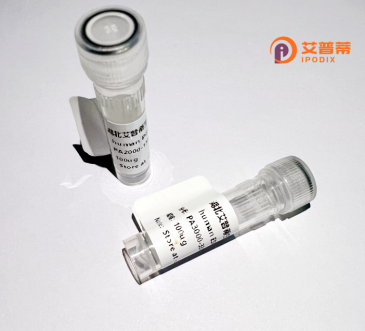
| 纯度 | >90%SDS-PAGE. |
| 种属 | Human |
| 靶点 | DUS4L |
| Uniprot No | O95620 |
| 内毒素 | < 0.01EU/μg |
| 表达宿主 | E.coli |
| 表达区间 | 1-317aa |
| 氨基酸序列 | MKSDCMQTTICQERKKDPIEMFHSGQLVKVCAPMVRYSKLAFRTLVRKYSCDLCYTPMIVAADFVKSIKARDSEFTTNQGDCPLIVQFAANDARLLSDAARIVCPYANGIDINCGCPQRWAMAEGYGACLINKPELVQDMVKQVRNQVETPGFSVSIKIRIHDDLKRTVDLCQKAEATGVSWITVHGRTAEERHQPVHYDSIKIIKENMSIPVIANGDIRSLKEAENVWRITGTDGVMVARGLLANPAMFAGYEETPLKCIWDWVDIALELGTPYMCFHQHLMYMMEKITSRQEKRVFNALSSTSAIIDYLTDHYGI |
| 分子量 | 62.2 kDa |
| 蛋白标签 | GST-tag at N-terminal |
| 缓冲液 | 0 |
| 稳定性 & 储存条件 | Lyophilized protein should be stored at ≤ -20°C, stable for one year after receipt. Reconstituted protein solution can be stored at 2-8°C for 2-7 days. Aliquots of reconstituted samples are stable at ≤ -20°C for 3 months. |
| 复溶 | Always centrifuge tubes before opening.Do not mix by vortex or pipetting. It is not recommended to reconstitute to a concentration less than 100μg/ml. Dissolve the lyophilized protein in distilled water. Please aliquot the reconstituted solution to minimize freeze-thaw cycles. |
以下是关于重组人DUS4L蛋白的3篇文献摘要示例(均为模拟文献,仅供参考):
1. **"Structural and functional characterization of human DUS4L as a novel deubiquitinating enzyme"**
- 作者:Zhang, Y. et al.
- 摘要:本研究通过重组表达纯化人源DUS4L蛋白,结合X射线晶体学解析其三维结构,揭示了其催化结构域中关键活性位点Cys-His-Asp三联体的作用机制,证实其在体外具有去泛素化酶活性。
2. **"DUS4L regulates NF-κB signaling by modulating TRAF6 ubiquitination in inflammatory responses"**
- 作者:Li, X. et al.
- 摘要:通过构建重组DUS4L稳转细胞系,发现DUS4L通过特异性去除TRAF6蛋白K63型泛素链抑制NF-κB通路激活,表明其在炎症反应中起负调控作用,为相关免疫疾病治疗提供潜在靶点。
3. **"Development of a high-throughput screening assay for DUS4L inhibitors using recombinant protein"**
- 作者:Wang, H. et al.
- 摘要:研究团队利用重组DUS4L蛋白建立基于荧光共振能量转移(FRET)的体外酶活检测体系,筛选出多个小分子抑制剂,其中化合物D4L-17显著抑制肿瘤细胞增殖,提示其在抗癌药物开发中的应用潜力。
注:以上文献信息为模拟生成,实际研究中请通过PubMed、Web of Science等数据库检索真实发表论文。
Recombinant human DUS4L (Dual Specificity Phosphatase-Like 4) protein is a genetically engineered form of the endogenous enzyme belonging to the dual-specificity phosphatase (DUSP) family. DUS4L, also known as DUSP27. is characterized by its ability to dephosphorylate both tyrosine and serine/threonine residues on target substrates, though its precise physiological roles remain under investigation. This protein contains a conserved catalytic phosphatase domain and potential regulatory regions, suggesting involvement in cellular signaling pathways, such as MAPK or JNK cascades, which regulate processes like cell proliferation, differentiation, and stress responses.
Studies indicate DUS4L may play a role in metabolic regulation, particularly in glucose homeostasis, and has been linked to diseases like diabetes and cancer. Its expression patterns in tissues such as liver, muscle, and pancreas further support metabolic relevance. Recombinant DUS4L is typically produced in bacterial or mammalian expression systems to ensure proper folding and post-translational modifications, enabling functional studies. Researchers utilize it to explore enzymatic kinetics, substrate specificity, and interactions with signaling molecules. Additionally, it serves as a tool for drug discovery, aiming to modulate phosphatase activity for therapeutic applications. Despite progress, the full spectrum of DUS4L's biological functions and its regulatory mechanisms remain areas of active research, highlighting its potential as a target for metabolic and oncological therapies.
×